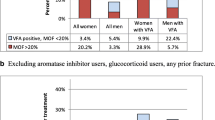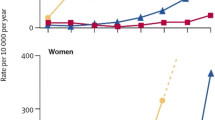Abstract
Vertebral fracture assessment (VFA) is a potential screening tool for vertebral fractures, but it is uncertain how to optimize the selection of women for VFA. We investigate the use of a probability score (VFscore) to select women for VFA screening and compare this to other means of targeting VFA. We identified 1,572 treatment-naive women over age 65 who had undergone routine VFA screening. Risk factors for fracture on VFA were identified using multivariate logistic regression, and a VFscore was created. Different thresholds of VFscore were examined and compared to using BMD as a means of targeting screening. After multivariate logistic regression, the risk factors significantly associated with the presence of a fracture on VFA were age, femoral neck BMD, prior clinical fracture, and height loss/kyphosis. The VFscore derived from these factors had a 65.5% sensitivity and a 65.5% specificity for determining vertebral fracture status. For equal resource requirements, the VFscore identified more women with fracture than using BMD category to target VFA. Compared to routinely screening all women, VFscore enabled a 30% reduction in the number of women undergoing VFA while still identifying >90% of women with a vertebral fracture. Overall, a large proportion of the population is required to undergo VFA in order to ensure that the majority of women with a vertebral fracture are selected for screening. The VFscore increased the efficiency of VFA screening to a modest degree compared to screening routinely or according to BMD category.


Similar content being viewed by others
References
Lindsay R, Silverman SL, Cooper C, Hanley DA, Barton I, Broy SB, Licata A, Benhamou L, Geusens P, Flowers K, Stracke H, Seeman E (2001) Risk of new vertebral fracture in the year following a fracture. JAMA 17(285):320–323
Black DM, Arden NK, Palermo L, Pearson J, Cummings SR (1999) Prevalent vertebral deformities predict hip fractures and new vertebral deformities but not wrist fractures. Study of Osteoporotic Fractures Research Group. J Bone Miner Res 14:821–828
Lunt M, O’Neill TW, Felsenberg D, Reeve J, Kanis JA, Cooper C, Silman AJ, European Prospective Osteoporosis Study Group (2003) Characteristics of a prevalent vertebral deformity predict subsequent vertebral fracture: results from the European Prospective Osteoporosis Study (EPOS). Bone 33:505–513
Kanis JA, Johnell O, Oden A, Johansson H, McCloskey E (2008) FRAX and the assessment of fracture probability in men and women from the UK. Osteoporos Int 19:385–397
Melton LJ III, Lane AW, Cooper C, Eastell R, O’Fallon WM, Riggs BL (1993) Prevalence and incidence of vertebral deformities. Osteoporos Int 3:113–119
Kaptoge S, Armbrecht G, Felsenberg D, Lunt M, Weber K, Boonen S, Jajic I, Stepan JJ, Banzer D, Reisinger W, Janott J, Kragl G, Scheidt-Nave C, Felsch B, Matthis C, Raspe HH, Lyritis G, Póor G, Nuti R, Miazgowski T, Hoszowski K, Armas JB, Vaz AL, Benevolenskaya LI, Masaryk P, Cannata JB, Johnell O, Reid DM, Bhalla A, Woolf AD, Todd CJ, Cooper C, Eastell R, Kanis JA, O’Neill TW, Silman AJ, Reeve J (2006) Whom to treat? The contribution of vertebral X-rays to risk-based algorithms for fracture prediction. Results from the European Prospective Osteoporosis Study. Osteoporos Int 17:1369–1381
Rea JA, Chen MB, Li J, Blake GM, Steiger P, Genant HK, Fogelman I (2000) Morphometric X-ray absorptiometry and morphometric radiography of the spine: a comparison of prevalent vertebral deformity identification. J Bone Miner Res 15:564–574
Rea JA, Li J, Blake GM, Steiger P, Genant HK, Fogelman I (2000) Visual assessment of vertebral deformity by X-ray absorptiometry: a highly predictive method to exclude vertebral deformity. Osteoporos Int 11:660–668
Binkley N, Krueger D, Gangnon R, Genant HK, Drezner MK (2005) Lateral vertebral assessment: a valuable technique to detect clinically significant vertebral fractures. Osteoporos Int 16:1513–1518
Middleton ET, Steel SA (2008) Routine versus targeted vertebral fracture assessment for the detection of vertebral fractures. Osteoporos Int 19:1167–1173
Royal College of Physicians (1999) Osteoporosis: clinical guidelines for the prevention and treatment. Royal College of Physicians, London. www.rcplondon.ac.uk/files/osteosummary.pdf
Laster AJ, Lewiecki EM, for the ISCD Board of Directors (2007) Vertebral fracture assessment by dual-energy X-ray absorptiometry: insurance coverage issues in the United States. A white paper of the International Society for Clinical Densitometry. J Clin Densitom 10:227–238
Collett D (2003) Modelling binary data, 2nd edn. Chapman and Hall/CRC, Boca Raton, FL, p 93
Kanis JA, Gluer CC (2000) An update on the diagnosis and assessment of osteoporosis with densitometry. Committee of Scientific Advisors, International Osteoporosis Foundation. Osteoporos Int 11:192–202
R Development Core Team (2008) R: a language and environment for statistical computing. R Foundation for Statistical Computing, Vienna, Austria. www.R-project.org
Kanis JA, Barton IP, Johnell O (2005) Risedronate decreases fracture risk in patients selected solely on the basis of prior vertebral fracture. Osteoporos Int 16:475–482
Quandt SA, Thompson DE, Schneider DL, Nevitt MC, Black DM (2005) Effect of alendronate on vertebral fracture risk in women with bone mineral density T scores of −1.6 to −2.5 at the femoral neck: the Fracture Intervention Trial. Mayo Clin Proc 80:343–349
Schousboe JT, Ensrud KE, Nyman JA, Kane RL, Melton LJIII (2006) Cost-effectiveness of vertebral fracture assessment to detect prevalent vertebral deformity and select postmenopausal women with a femoral neck T-score > −2.5 for alendronate therapy: a modeling study. J Clin Densitom 9:133–143
National Institute for Clinical Excellence (2005) Bisphosphonates (alendronate, etidronate, risedronate), selective oestrogen receptor modulators (raloxifene) and parathyroid hormone (teriparatide) for the secondary prevention of osteoporotic fragility fractures in postmenopausal women. Published appraisals, Technology Appraisal Guidance 87. http://www.nice.org.uk/guidance/index.jsp?action=byID&r=true&o=11550
McCloskey EV, Vasireddy S, Threlkeld J, Eastaugh J, Parry A, Bonnet N, Beneton M, Kanis JA, Charlesworth D (2008) Vertebral fracture assessment (VFA) with a densitometer predicts future fractures in elderly women unselected for osteoporosis. J Bone Miner Res. doi: 10.1359/jbmr.080515
Kaptoge S, Armbrecht G, Felsenberg D, Lunt M, O’Neill TW, Silman AJ, Reeve J, EPOS Study Group (2004) When should the doctor order a spine X-ray? Identifying vertebral fractures for osteoporosis care: results from the European Prospective Osteoporosis Study (EPOS). J Bone Miner Res 19:1982–1993
Felsenberg D, Silman AJ, Lunt M, Armbrecht G, Ismail AA, Finn JD, Cockerill WC, Banzer D, Benevolenskaya LI, Bhalla A, Bruges Armas J, Cannata JB, Cooper C, Dequeker J, Eastell R, Felsch B, Gowin W, Havelka S, Hoszowski K, Jajic I, Janott J, Johnell O, Kanis JA, Kragl G, Lopes Vaz A, Lorenc R, Lyritis G, Masaryk P, Matthis C, Miazgowski T, Parisi G, Pols HAP, Poor G, Raspe HH, Reid DM, Reisinger W, Scheidt-Nave C, Stepan JJ, Todd CJ, Weber K, Woolf AD, Yershova OB, Reeve J, O’Neill TW (2002) Incidence of vertebral fracture in Europe: results from the European Prospective Osteoporosis Study (EPOS). J Bone Miner Res 17:716–724
Kanis JA, Johnell O, Oden A, Johansson H, De Laet C, Eisman JA, Fujiwara S, Kroger H, McCloskey EV, Mellstrom D, Melton LJ, Pols H, Reeve J, Silman A, Tenenhouse A (2005) Smoking and fracture risk: a meta-analysis. Osteoporos Int 16:155–162
Kanis JA, Johansson H, Johnell O, Oden A, De Laet C, Eisman JA, Pols H, Tenenhouse A (2005) Alcohol intake as a risk factor for fracture. Osteoporos Int 16:737–742
Ismail AA, Cooper C, Felsenberg D, Varlow J, Kanis JA, Silman AJ, O’Neill TW (1999) Number and type of vertebral deformities: epidemiological characteristics and relation to back pain and height loss. European Vertebral Osteoporosis Study Group. Osteoporos Int 9:206–213
Van der Klift M, De Laet CE, McCloskey EV, Hofman A, Pols HA (2002) The incidence of vertebral fractures in men and women: the Rotterdam Study. J Bone Miner Res 17:1051–1056
Author information
Authors and Affiliations
Corresponding author
Rights and permissions
About this article
Cite this article
Middleton, E.T., Gardiner, E.D. & Steel, S.A. Which Women Should Be Selected for Vertebral Fracture Assessment? Comparing Different Methods of Targeting VFA. Calcif Tissue Int 85, 203–210 (2009). https://doi.org/10.1007/s00223-009-9268-0
Received:
Accepted:
Published:
Issue Date:
DOI: https://doi.org/10.1007/s00223-009-9268-0




